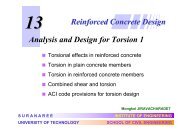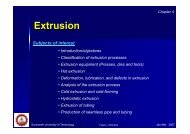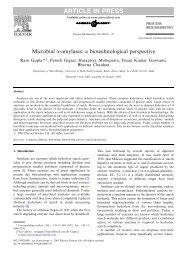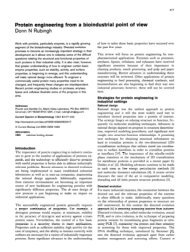You also want an ePaper? Increase the reach of your titles
YUMPU automatically turns print PDFs into web optimized ePapers that Google loves.
<strong>Fracture</strong><br />
Subjects of interest<br />
• Introduction/ objectives<br />
• Types of fracture in metals<br />
• Theoretical cohesive strength of metals<br />
• The development in theories of brittle fracture<br />
• Fractographic observation in brittle fracture<br />
• Ductile fracture<br />
• Ductile to brittle transition behaviour<br />
• Intergranular fracture<br />
• Factors affecting modes of fracture<br />
• Concept of the fracture curve<br />
<strong>Chapter</strong> 7<br />
Suranaree University of Technology May-Aug 2007<br />
Tapany Udomphol
Objectives<br />
• This chapter provides the development in the<br />
theories of brittle fractures together with mechanisms<br />
of fracture that might occur in metallic materials.<br />
• Factors affecting different types of fracture<br />
processes such as brittle cleavage fracture, ductile<br />
failure or intergranular fracture will be discussed.<br />
Suranaree University of Technology May-Aug 2007<br />
Tapany Udomphol
Introduction<br />
Failure in structures leads to lost of<br />
properties and sometimes lost of<br />
human lives unfortunately.<br />
Failure of Liberty Ships during<br />
services in World War II.<br />
Failed fuselage of the Aloha 737<br />
aircraft in 1988.<br />
Collapse of Point Pleasant suspension<br />
bridge, West Virginia, 1967.<br />
Suranaree University of Technology May-Aug 2007<br />
Tapany Udomphol
Types of fracture in metals<br />
• The concept of material strength and fractures has long been<br />
studied to overcome failures.<br />
• The introduction of malleable irons during the revolution of<br />
material construction led to the perception of brittle and ductile<br />
fractures as well as fatigue failure in metals.<br />
Failure in metallic materials<br />
can be divided into two<br />
main categories;<br />
Theories of brittle fracture<br />
Ductile failure<br />
Ductile fracture involves a large<br />
amount of plastic deformation and<br />
can be detected beforehand.<br />
Brittle failure<br />
Brittle fracture is more catastrophic<br />
and has been intensively studied.<br />
Suranaree University of Technology May-Aug 2007<br />
Tapany Udomphol
Failure modes<br />
Ductile fracture Brittle fracture<br />
• High energy is absorbed by<br />
microvoid coalescence during<br />
ductile failure (high energy<br />
fracture mode)<br />
Less catastrophic<br />
• Low energy is absorbed during<br />
transgranular cleavage fracture<br />
(low energy fracture mode)<br />
More catastrophic<br />
Suranaree University of Technology May-Aug 2007<br />
Tapany Udomphol
Cohesive force, σσ<br />
Theoretical cohesive strength of<br />
metal<br />
• In the most basic term, strength is due to the cohesive forces<br />
between atoms.<br />
• The attractive and repulsive force acting on the two atoms<br />
lead to cohesive force between two atoms which varies in<br />
relation to the separation between these atoms, see fig.<br />
a o<br />
σσσσ max<br />
Separation<br />
between<br />
atoms, x<br />
Cohesive force as a function of<br />
the separation between atoms.<br />
The theoretical cohesive strength<br />
σσσσ max can be obtained in relation to<br />
the sine curve and become.<br />
Suranaree University of Technology May-Aug 2007<br />
1 2<br />
max ⎟ Where<br />
⎛ Eγ s ⎞<br />
σ =<br />
⎜<br />
⎝ ao<br />
⎠<br />
...Eq. 1<br />
γγγγ s is the surface energy<br />
ao is the unstrained interatomic spacing.<br />
Note: Convenient estimates of σσσσ max ~ E/10.<br />
Tapany Udomphol
<strong>Fracture</strong> in single crystals<br />
The brittle fracture of single crystals is related to the resolved<br />
normal stress on the cleavage plane.<br />
Sohncke’s law states that fracture occurs<br />
when the resolved normal stress reaches a<br />
critical value.<br />
From the critical resolved shear stress ττττ R for slip<br />
P cosλ<br />
P<br />
τ R = = cosφ<br />
cosλ<br />
A/<br />
cosφ<br />
A<br />
σ<br />
c<br />
=<br />
P cosφ<br />
=<br />
A / cosφ<br />
P<br />
A<br />
2<br />
cos<br />
φ<br />
...Eq. 2<br />
The critical normal stress σσσσ c for brittle fracture<br />
...Eq. 3<br />
Suranaree University of Technology May-Aug 2007<br />
ττττ R<br />
λλλλ<br />
Slip<br />
direction<br />
Note: shear stress slip<br />
tensile stress crack propagation fracture.<br />
Tapany Udomphol<br />
P<br />
A<br />
P<br />
A’<br />
φφφφ<br />
N<br />
Normal<br />
stress<br />
Slip<br />
plane
Example: Determine the cohesive strength of a silica fibre,<br />
if E = 95 GPa, γγγγ s = 1 J.m -2 , and a o = 0.16 nm.<br />
σ<br />
max<br />
1 2<br />
9<br />
⎛ Eγ<br />
s ⎞ ⎛ 95×<br />
10 ×<br />
=<br />
⎜<br />
9<br />
a ⎟ = ⎜<br />
−<br />
o 0.<br />
16×<br />
10<br />
⎝<br />
⎠<br />
⎝<br />
24.<br />
4<br />
GPa<br />
• This theoretical cohesive strength is exceptionally higher than<br />
the fracture strength of engineering materials.<br />
• This difference between cohesive and fracture strength is due to<br />
inherent flaws or defects in the materials which lower the<br />
fracture strength in engineering materials.<br />
• Griffith explained the discrepancy between the fracture<br />
strength and theoretical cohesive strength using the concept<br />
of energy balance.<br />
Suranaree University of Technology May-Aug 2007<br />
1⎞<br />
⎟<br />
⎠<br />
1 2<br />
Tapany Udomphol<br />
=
Theories of brittle fracture<br />
Griffith theory of brittle fracture<br />
The first analysis on cleavage fracture was initiated by Griffith<br />
using the concept of energy balance in order to explain<br />
discrepancy between the theoretical cohesive strength and<br />
observed fracture strength of ideally brittle material.<br />
The development in cleavage fracture models<br />
• Modified Griffith theory by Irwin and Orowan.<br />
• Zener’s model of microcrack formation at a pile-up of<br />
edge dislocations.<br />
• Stroh’s model of cleavage crack formation by dislocation<br />
pile-up.<br />
• Cottrell’s model of cleavage crack initiation in BCC metals<br />
• Smith’s model of microcrack formation in grain boundary<br />
carbide film.<br />
Suranaree University of Technology May-Aug 2007<br />
Tapany Udomphol
Griffith theory of brittle fracture<br />
Observed fracture strength is<br />
always lower than theoretical<br />
cohesive strength<br />
Crack propagation criterion:<br />
Consider a through thickness crack of length 2a,<br />
subjected to a uniform tensile stress σσσσ, at infinity.<br />
Crack propagation occurs when the released<br />
elastic strain energy is at least equal to the<br />
energy required to generate new crack surface.<br />
• The stress required to<br />
create the new crack surface<br />
is given as follows;<br />
• In plane strain condition,<br />
Eq.4 becomes<br />
σ =<br />
Griffith explained that the discrepancy<br />
is due to the inherent defects in brittle<br />
materials leading to stress<br />
concentration. lower the fracture<br />
strength of the materials<br />
⎛<br />
⎜<br />
⎝<br />
2<br />
Eγ s<br />
πa<br />
⎛ 2<br />
σ = ⎜<br />
⎝ ( 1−<br />
υ<br />
Suranaree University of Technology May-Aug 2007<br />
⎞<br />
⎟<br />
⎠<br />
1 2<br />
Eγ s<br />
2<br />
)<br />
⎞<br />
⎟<br />
πa<br />
⎠<br />
Tapany Udomphol<br />
1 2<br />
...Eq. 4<br />
...Eq. 5<br />
σ<br />
2a<br />
σ<br />
Griffith crack model<br />
The Griffith’s<br />
equation
Modified Griffith equation<br />
• The Griffith equation is strongly dependent on the crack size a,<br />
and satisfies only ideally brittle materials like glass.<br />
• However, metals are not ideally brittle and normally fail with<br />
certain amounts of plastic deformation, the fracture stress is<br />
increased due to blunting of the crack tip.<br />
• Irwin and Orowan suggested Griffith’s equation can be<br />
applied to brittle materials undergone plastic deformation<br />
before fracture by including the plastic work, γγγγ p , into the total<br />
elastic surface energy required to extend the crack wall, giving<br />
the modified Griffith’s equation as follows<br />
1 2<br />
⎡2E<br />
( γ s + γ p ) ⎤ ⎛ Eγ<br />
p ⎞<br />
σ ⎢<br />
, γ >> γ<br />
2 ⎥ ≈<br />
2<br />
2<br />
π ( 1 υ ) ⎜<br />
( 1 υ ) ⎟<br />
f = when p<br />
⎣ − a ⎦ ⎝ − a ⎠<br />
Suranaree University of Technology May-Aug 2007<br />
1 2<br />
Tapany Udomphol<br />
...Eq. 6
Zener’s model of microcrack formation<br />
at a pile-up of edge dislocations<br />
The Griffith theory only indicated the stress required for crack<br />
propagation of an existing crack of length 2a but did not explain<br />
the nucleation of the crack.<br />
Zener and Stroh showed that the crack nucleation of length 2c<br />
occurs when the shear stress ττττ s created by pile-up of n dislocations<br />
of Burgers vector b at a grain boundary reaches the value of<br />
τ<br />
s<br />
⎛ 2γ<br />
s<br />
≈ τ i + ⎜<br />
⎝ nb<br />
⎞<br />
⎟<br />
⎠<br />
...Eq. 7<br />
Where ττττ i is the lattice friction stress<br />
in the slip plane.<br />
Source<br />
Dislocation pile-ups at barrier.<br />
Suranaree University of Technology May-Aug 2007<br />
ττττ s<br />
L<br />
nb<br />
Barrier<br />
2c
Stroh’s model of cleavage crack<br />
formation by dislocation pile-up<br />
Stroh included the effect of the grain size d in a model, suggesting<br />
the condition of the shear stress created by dislocation pile-up of<br />
the length d/2 to nucleate a microcrack as follows<br />
τ<br />
= τ<br />
Eπγ<br />
4( 1−<br />
υ )d<br />
eff y i<br />
2<br />
where<br />
ττττ eff<br />
ττττ y<br />
−τ<br />
...Eq. 8<br />
is the effective shear stress<br />
is the yield stress<br />
Note: This model indicates that the<br />
fracture of the material should depend<br />
only on the shear stress acting on the<br />
slip band.<br />
Dislocation pile-up<br />
forming micocrack<br />
Suranaree University of Technology May-Aug 2007<br />
Tapany Udomphol<br />
τ−τ l<br />
d/2<br />
r<br />
σ θθ<br />
θθ<br />
σ θθ<br />
θθ<br />
σθθ θθ<br />
θθ<br />
Stroh’s model of cleavage crack<br />
formation by dislocation pile-up.<br />
r
Cottrell’s model of cleavage crack<br />
initiation in BCC metals<br />
Cottrell later suggested that the fracture process should be controlled<br />
by the critical crack growth stage under the applied tensile stress,<br />
which required higher stress than the crack nucleation itself as<br />
suggested by Stroh.<br />
Cottrell also showed that the crack<br />
nucleation stress can be small if the<br />
microcrack is initiated by intersecting<br />
of two low energy slip planes to<br />
provide a preferable cleavage plane.<br />
a<br />
2<br />
a<br />
+ ...Eq. 9<br />
2<br />
[ 111]<br />
[ 111]<br />
→ a[<br />
001]<br />
This results in a wedge cleavage crack on<br />
the (001) plane. Further propagation of this<br />
crack is then controlled by the applied<br />
tensile stress.<br />
(001) Cleavage plane<br />
Suranaree University of Technology May-Aug 2007<br />
a<br />
2<br />
a<br />
2<br />
[ 111]<br />
b = a[<br />
001]<br />
[ 111]<br />
a<br />
2<br />
σ<br />
(101) Slip plane<br />
(101) Slip plane<br />
a<br />
2<br />
σ<br />
Applied stress<br />
Cleavage knife crack<br />
of length c for<br />
displacement nb<br />
[ 111]<br />
+ [ 111]<br />
→ a[<br />
001]<br />
Cottrell’s model of cleavage crack<br />
initiation in BCC metals
Smith’s model of microcrack formation<br />
in grain boundary carbide film<br />
Models proposed by Stroh and Cottrell<br />
involve crack initiation by dislocation<br />
pile-up of length D/2, but exclude the<br />
effect of second phase particles.<br />
Smith then proposed a model for cleavage<br />
fracture in mild steel concerning<br />
microcracking of grain boundary carbide by<br />
dislocation pile-up of length equal to half of<br />
the grain diameter D/2.<br />
Microcrack is initiated when sufficiently high<br />
applied stress causes local plastic strain<br />
within the ferrite grains to nucleate<br />
microcrack in brittle grain boundary<br />
carbide of thickness Co .<br />
Grain boundary carbide film<br />
Ferrite grain<br />
Microcrack<br />
Suranaree University of Technology May-Aug 2007<br />
σ<br />
σ<br />
ττττ eff<br />
Ferrite grain<br />
D<br />
ττττ eff<br />
Smith’s model of microcrack formation in<br />
grain boundary carbide film<br />
1<br />
2<br />
c C<br />
Eγ<br />
2 ⎛ o ⎞ 2 ⎪<br />
⎧ 4 ⎛ o ⎞ τ i ⎪<br />
⎫ 4 p<br />
σ f ⎜ ⎟ + τ eff ⎨1<br />
+ ⎜ ⎟ ⎬ ≥ 2<br />
⎝ d ⎠ ⎪⎩<br />
π ⎝ d ⎠ τ eff ⎪⎭<br />
C o<br />
2<br />
...Eq. 10<br />
( 1−<br />
υ ) πd<br />
Note: Further propagation of the GB carbide crack follows the Griffith theory.<br />
Tapany Udomphol
Fractographic observation<br />
in brittle fracture<br />
The process of cleavage fracture<br />
consists of three steps:<br />
1) Plastic deformation to produce<br />
dislocation pile-ups.<br />
2) Crack initiation.<br />
3) Crack propagation to failure.<br />
Distinct characteristics of brittle<br />
fracture surfaces:<br />
1) The absence of gross plastic<br />
deformation.<br />
2) Grainy or Faceted texture.<br />
3) River marking or stress lines.<br />
Brittle fracture indicating the origin of the<br />
crack and crack propagation path<br />
Suranaree University of Technology May-Aug 2007<br />
Tapany Udomphol
Brittle fracture surface<br />
• Cleavage fracture surface is<br />
characterised by flat facets (with its size<br />
normally similar to the grain size).<br />
• River lines or the stress lines are steps<br />
between cleavage on parallel planes and<br />
always converge in the direction of local<br />
crack propagation.<br />
Twist boundary<br />
Schematic of river-line pattern.<br />
Cleavage facet<br />
River marking<br />
or stress lines<br />
Fatigue pre-crack front<br />
Brittle cleavage facet<br />
Crack<br />
growth<br />
direction<br />
Suranaree University of Technology May-Aug 2007<br />
Tapany Udomphol
Initiation of microcracks from<br />
deformation and twins<br />
• Microcracks can be<br />
produced by the deformation<br />
process, see fig.<br />
250 x<br />
Microcracks produced in iron by<br />
tensile deformation at 133 K.<br />
• Microcracks can also be initiated at<br />
mechanical twins, especially in large<br />
grained bcc metals at low<br />
temperature.<br />
• Crack initiation sites are due to the<br />
intersections of twins with other twins<br />
or intersection of twins with grain<br />
boundaries.<br />
Cleavage along twin-matrix interfaces.<br />
Suranaree University of Technology May-Aug 2007<br />
Tapany Udomphol
Crack initiation from particles in<br />
cleavage fracture<br />
Crack initiation site<br />
• Inclusions, porosity, secondphase<br />
particles or precipitates are<br />
preferential sites (stress raiser)<br />
for cleavage initiation.<br />
• <strong>Fracture</strong> occurs along the<br />
crystallographic planes.<br />
• The direction of the river<br />
pattern represents the direction<br />
of the crack propagation.<br />
Suranaree University of Technology May-Aug 2007<br />
Tapany Udomphol
Example: Crack initiation from carbide particles<br />
observed in ββββ-Ti alloy.<br />
Titanium carbides act as stress raiser which are preferential<br />
site for transgranular cleavage fracture.<br />
Group of brittle facets<br />
Fatigue pre-crack front<br />
High local tensile stresses raised by<br />
dislocation pile-ups ahead of the carbide<br />
cause micro-cracking of carbide, which<br />
further propagate to cause global failure.<br />
Fatigue pre-crack front<br />
carbide<br />
Suranaree University of Technology May-Aug 2007<br />
Tapany Udomphol
Effects of second phase particles on<br />
tensile ductility<br />
• Second-phase particles which are<br />
readily cut by dislocation produce<br />
planar slips, producing large<br />
dislocation pile-ups which are<br />
susceptible for brittle fracture.<br />
• Second-phase particles which are<br />
impenetrable by dislocations,<br />
greatly reduce the slip distance <br />
the number of dislocations is<br />
sustained reduce the pile-up.<br />
• Small spherical particles (r
Ductile fracture<br />
Ductile fracture is a much less serious<br />
problem in engineering materials since<br />
failure can be detected beforehand due<br />
to observable plastic deformation<br />
prior to failure.<br />
• Under uniaxial tensile force, after<br />
necking, microvoids form and<br />
coalesce to form crack, which then<br />
propagate in the direction normal to<br />
the tensile axis.<br />
• The crack then rapidly propagate<br />
through the periphery along the shear<br />
plane at 45 o , leaving the cub and<br />
cone fracture.<br />
Necking<br />
Propagation along<br />
shear plane<br />
Microvoid<br />
formation and<br />
coalescence<br />
Stages in cup and cone fracture<br />
Crack<br />
propagation<br />
Typical cup and<br />
cone fracture<br />
Suranaree University of Technology May-Aug 2007
Microvoid formation, growth and<br />
coalescence<br />
• Microoids are easily formed at inclusions,<br />
intermetallic or second-phase particles and<br />
grain boundaries.<br />
• Growth and coalescence of microvoids<br />
progress as the local applied load<br />
increases.<br />
a) Random planar array<br />
of particles acting as<br />
void initiators.<br />
b) Growth of voids to join<br />
each other as the applied<br />
stress increases.<br />
Ductile dimples centred on<br />
spherical particles<br />
c) Linkage or coalescence<br />
of these voids to form free<br />
fracture surface.<br />
Suranaree University of Technology May-Aug 2006<br />
Tapany Udomphol
Formation of microvoids from second<br />
phase particles<br />
Microvoids are formed by<br />
1) Decohesion at particle-matrix interface.<br />
2) <strong>Fracture</strong> of brittle particle<br />
3) Decohesion of an interface associated<br />
with shear deformation or grain<br />
boundary sliding.<br />
Decohesion of carbide particles<br />
from Ti matrix.<br />
Mechanisms of microvoid formation<br />
<strong>Fracture</strong>d carbide<br />
<strong>Fracture</strong>d carbides aiding<br />
microvoid formation.<br />
Suranaree University of Technology May-Aug 2007<br />
Tapany Udomphol
Uniaxial<br />
tensile<br />
loading<br />
Shear<br />
Tensile<br />
tearing<br />
Microvoid shape<br />
Microvoid shape is strongly influenced by the type of loading.<br />
Formation of microvoids or dimples owing to<br />
uniaxial tensile loading, shear and tensile tearing<br />
Uniaxial tensile loading<br />
Equiaxed dimples.<br />
Shear loading<br />
Elongated and parabolic dimples<br />
pointing in the opposite directions<br />
on matching fracture surfaces.<br />
Tensile tearing<br />
Elongated dimples pointing in the<br />
same direction on matching fracture<br />
surface.<br />
Suranaree University of Technology May-Aug 2007<br />
Tapany Udomphol
Ductile to brittle transition behaviour<br />
BCC structure metals experience ductile-to-brittle transition<br />
behaviour when subjected to decreasing temperature, resulting<br />
from a strong yield stress dependent on temperature.<br />
• BCC metals possess limited<br />
slip systems available at low<br />
temperature, minimising the<br />
plastic deformation during the<br />
fracture process.<br />
• Increasing temperature<br />
allows more slip systems to<br />
operate, yielding general<br />
plastic deformation to occur<br />
prior to failure.<br />
TOUGHNESS<br />
Low temperature<br />
High temperature<br />
BRITTLE<br />
(CLEAVAGE)<br />
INITIATION<br />
LOWER SHELF<br />
MACROSCOPIC (MICROSCOPIC) LEVEL OF OBSERVATION<br />
BRITTLE (CLEAVAGE)<br />
PROPAGATION<br />
DYNAMIC<br />
LOADING<br />
INCREASING<br />
SHEAR<br />
(CLEAVAGE OR<br />
MICROVOID<br />
COALESCENCE)<br />
DYNAMIC<br />
FULL SHEAR PROPAGATION<br />
(MICROVOID COALESCENCE)<br />
Suranaree University of Technology May-Aug 2007<br />
Tapany Udomphol<br />
DUCTILE INITIATION (MICROVOID<br />
COALESCENCE)<br />
INCREASING SIZE OF<br />
FIBROUS THUMNAIL<br />
BRITTLE<br />
SLOW<br />
LOADING<br />
TEMPERATURE<br />
MIXED MODE<br />
DUCTILE<br />
UPPER SHELF<br />
Brittle cleavage fracture<br />
Ductile fracture<br />
SLOW
where<br />
Theory of the ductile to brittle transition<br />
The criterion for a material to change its fracture behaviour from<br />
ductile to brittle mode is when the yield stress at the observed<br />
temperature is larger than the stress necessary for the growth<br />
of the microcrack indicated in the Griffith theory.<br />
Cottrell studied the role of parameters, which influence the ductileto-brittle<br />
transition as follows;<br />
The criterion for ductile to brittle<br />
...Eq. 11<br />
transition is when the term on<br />
( 1 2 '<br />
τ ) '<br />
i D + k k = Gγ<br />
sβ<br />
the left hand side is greater than<br />
the right hand side.<br />
ττττ i is the lattice resistance to dislocation movement<br />
k’ is a parameter related to the release of dislocation into a pile-up<br />
D is the grain diameter (associated with slip length).<br />
G is the shear modulus<br />
ββββ is a constant depending on the stress system.<br />
Suranaree University of Technology May-Aug 2007<br />
Tapany Udomphol
Factors affecting ductile to brittle<br />
transition<br />
From equation, materials having high<br />
lattice resistance ττττ i ,grain size D and<br />
k’ has a high tendency to become<br />
brittle with decreasing temperature.<br />
• The ττττ i in BCC material is strongly<br />
dependent on temperature.<br />
• Materials with high k’ i.e., Fe and Mo<br />
are more susceptible for brittle fracture.<br />
• Smaller grain sized metals can<br />
withstand brittle behaviour better.<br />
Note: Alloy chemistry and microstructure also<br />
affect the ductile to brittle transition behaviour.<br />
In mild steel Ni lowers DBTT<br />
C, P, N, S, Mo raise DBTT<br />
( 1 2 ' ) '<br />
D + k k = Gγ<br />
β<br />
τ i<br />
s<br />
Effect of grain size on the yield and<br />
fracture stresses for a low-carbon<br />
steel tested in tension at -196 o C.<br />
Suranaree University of Technology May-Aug 2007<br />
Tapany Udomphol
Intergranular fracture<br />
• Intergranular failure is<br />
a moderate to low energy<br />
brittle fracture mode resulting<br />
from grain boundary<br />
separation or segregation of<br />
embrittling particles or<br />
precipitates.<br />
• Embrittling grain<br />
boundary particles are<br />
weakly bonded with the<br />
matrix, high free energy<br />
and unstable, which leads to<br />
preferential crack<br />
propagation path.<br />
Intergranular fracture<br />
with microvoid<br />
coalescence<br />
Intergranular fracture<br />
without microvoid<br />
coalescence<br />
Intergranular fracture with and without<br />
microvoid coalescence.<br />
Suranaree University of Technology May-Aug 2007<br />
Tapany Udomphol
Factors affecting modes of fracture<br />
Metallurgical aspect<br />
Temperature<br />
State of stresses<br />
(notch effect)<br />
Strain rate<br />
Loading condition<br />
Brittle fracture Ductile fracture<br />
Large grained materials<br />
with GB particles.<br />
Fine grained material<br />
without GB particles.<br />
Low temperature High temperature<br />
Triaxial state of<br />
stresses (notch effect)<br />
Absence of the notch<br />
High strain rate Low strain rate<br />
Hydrostatic pressure<br />
(suppress crack initiation)<br />
Suranaree University of Technology May-Aug 2007<br />
Tapany Udomphol
Metallurgical aspect of fracture<br />
• Microstructure in metallic materials are highly complex.<br />
• Various microstructural features affect how the materials fracture.<br />
Microstructural features in metallic materials<br />
• High strength materials usually possess<br />
several microstructural features in order to<br />
optimise mechanical properties by<br />
influencing deformation behaviour /<br />
fracture paths.<br />
There are microstructural<br />
features that can play a role in<br />
determining the fracture path,<br />
the most important are;<br />
Second phase<br />
Particles and precipitates<br />
Grain size<br />
Fibering and texturing<br />
Suranaree University of Technology May-Aug 2007<br />
Tapany Udomphol
State of stresses (notch effect)<br />
The difference in the state of stresses in the presence of a<br />
sharp crack or notch affects fracture in materials.<br />
A notch or a sharp crack increases the tendency<br />
for brittle fracture in four important ways;<br />
1) Producing high local stresses<br />
2) Introducing a triaxial state of stresses<br />
3) Producing high local strain hardening and cracking<br />
4) Producing a local magnification to the strain rate.<br />
Note: the notch also raises the plastic-constraint factor q,<br />
which does not exceed the value of 2.75<br />
Suranaree University of Technology May-Aug 2007<br />
Tapany Udomphol
notch effect<br />
The presence of the notch alters stress distribution<br />
• In a thin plate, stress in the z<br />
(thickness) direction is absence,<br />
the specimen is not constrained.<br />
• In thicker plate, σσσσ y (in the<br />
tensile direction) is constrained<br />
due to the reaction of σσσσ z and<br />
σσσσ x , leading to triaxial state of<br />
stresses.<br />
• Triaxial stresses limit plastic<br />
deformation ahead of the crack<br />
tip raising the general yield<br />
material prone to brittle<br />
fracture<br />
Elastic stresses beneath a notch in thin<br />
and thick plates<br />
Suranaree University of Technology May-Aug 2007<br />
Tapany Udomphol
Effects of combined stress and<br />
hydrostatic pressure on fracture<br />
Combined stress Hydrostatic pressure<br />
• Yielding under complex states of<br />
stress is difficult to predict.<br />
• Available data on ductile metals,<br />
i.e., Al and Mg alloys and steel<br />
indicate that the maximum-shear<br />
stress criterion for fracture are in<br />
the best agreement.<br />
Proposed fracture criteria for biaxial<br />
state of stress in ductile metal<br />
• hydrostatic pressure is triaxial<br />
compressive stress resist fracture<br />
and increase ductility.<br />
• Hydrostatic pressure exerts no<br />
shear stress, it therefore does not<br />
influence crack initiation but<br />
affects crack propagation.<br />
Effect of hydrostatic pressure on<br />
ductility in tension<br />
Suranaree University of Technology May-Aug 2007<br />
Tapany Udomphol
Concept of the fracture curve<br />
Ludwik proposed that a metal has a fracture stress curve<br />
in addition to a flow curve (true stress - true strain curve)<br />
and that fracture occurs when the flow curve intersects<br />
the fracture curve.<br />
• The plastic deformation is<br />
inhibited when strain hardening,<br />
triaxial stress, or high strain rate,<br />
causing sufficiently high stress to<br />
break the material.<br />
• <strong>Fracture</strong> stress is difficult to<br />
measure since most metals exhibit<br />
small plastic deformation prior to<br />
failure even in the presence of the<br />
notch and at very low temperature.<br />
True strain ε<br />
Suranaree University of Technology May-Aug 2007<br />
True stress σ<br />
Tapany Udomphol<br />
<strong>Fracture</strong> curve<br />
Flow curve<br />
<strong>Fracture</strong> strain<br />
Intersection of flow curve and<br />
fracture curve.
Notch effect on transition temperature<br />
The fracture stress σσσσ f is much less temperature sensitive<br />
than the flow stress σσσσ o .<br />
• The σσσσ o of the unnotched specimen<br />
is lower than σσσσ f at temperatures<br />
above the transition temperature.<br />
• The metal therefore deforms<br />
plastically before fracture. Below the<br />
transition temperature σσσσ o > σσσσ f , metal<br />
fails without plastic deformation.<br />
• The presence of the notch<br />
raises the σσσσ o by the plasticconstraint<br />
factor q. This shifts<br />
the transition temperature to the<br />
right hand side.<br />
Temperature<br />
Suranaree University of Technology May-Aug 2007<br />
Strength<br />
Cleavage<br />
strength<br />
Transition temperature<br />
in simple tension<br />
Tapany Udomphol<br />
qσσσσ o<br />
σσσσ f<br />
σσσσ o<br />
Notch transition<br />
temperature<br />
Description of transition temperature
References<br />
• Dieter, G.E., Mechanical metallurgy, 1988, SI metric edition,<br />
McGraw-Hill, ISBN 0-07-100406-8.<br />
• Sanford, R.J., Principles of fracture mechanics, 2003, Prentice<br />
Hall, ISBN 0-13-192992-1.<br />
• W.D. Callister, Fundamental of materials science and<br />
engineering/ an interactive e. text., 2001, John Willey & Sons, Inc.,<br />
New York, ISBN 0-471-39551-x.<br />
• Hull, D., Bacon, D.J., Introduction to dislocations, 2001, Forth<br />
edition, Butterworth-Heinemann, ISBN 0-7506-4681-0.<br />
• Smallman, R.E., Bishop, R.J., Modern physical metallurgy &<br />
materials engineering, 1999, sixth edition, Butterworth-Heinemann,<br />
ISBN 0-7506-4564-4.<br />
Suranaree University of Technology May-Aug 2007<br />
Tapany Udomphol
References<br />
• Cottrell, A.H., Theory of brittle fracture in steel and similar metals,<br />
1958, Transactions of the metallurgical society of AIME, Vol. 212,<br />
p. 192-203.<br />
• Stroh, A.N., Advanced Physics, 1957. Vol 6: p. 418<br />
Suranaree University of Technology May-Aug 2007<br />
Tapany Udomphol










